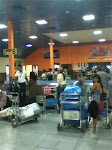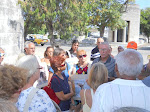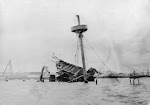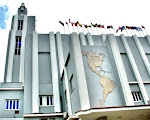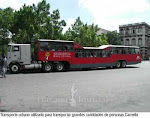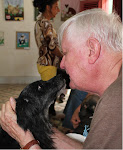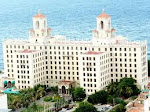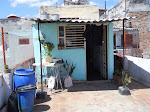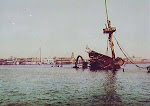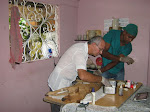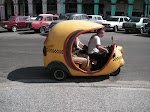My Little Black Book
After six years of working with Aniplant, a Cuban organization that protects animals, I have developed an interesting address book of people who have their own links to Cuba. I get calls, here and there, from people who do interesting things in Cuba, sometimes for animals, sometimes for humanitarian projects, and some even for religious work in Cuba.
The first contact in my address book I found browsing on the Internet. I had had a friend, Margaret, who visited Cuba as part of an educational tour to Havana. This was before George Bush cut off such educational contacts. I have always been curious about Cuba, and I wanted to visit there, but Bush moved faster than I did, and tours like the one Margaret took were terminated by the US Government before I could arrange one. But my Internet browsing found Rick Schwag, President of Caribbean Medical Transport, an idiosyncratic lover of The Pearl of the Antilles.
Rick had a license from the US Government to affiliate with people and authorize their trips to Cuba for humanitarian purposes. Thus began our adventure helping Cuban animals. Rick still helps Cuba by sending shipping containers full of donated mattresses, bicycles, wheelchairs, medicines, etc.
Another important contact in my address book is Alex Vicente, my travel agent. Alex is a Cuban American, makes several trips a year from Miami to Havana, and his travel agency, ABC Charters of Miami, arranges charter flights on a regular schedule back and forth to Havana. Many people think travel to Cuba is illegal, but it's not--it's just complicated. Alex can help anyone going for the right reasons.
A woman named Darci Gallati who lives in Canada found her way into my address book. Her organization, Candi International, is a charity that helps people fly newly adopted animals out of the Caribbean to new homes in the north. That activity, too, is complicated, but they're good at it and have made many families more complete with loving adopted companion animals.
My address book is replete with names of veterinarians and vet techs who have traveled to Cuba and participated in Nora's traveling weekend sterilization campaigns--names like Sylvia McAllister, Scott and Paula Mather, Dr. Dick White, and others who have spread their skills far beyond the neighborhoods where they keep their offices.
I could go on for many pages, but you get the idea. This is not just a few animal lovers trying to do good things; it's a huge informal network of good people who have had the kindness to focus on Cuba and make a difference for the animals and people there.
Les Inglis
Saturday, June 25, 2011
Saturday, June 11, 2011
Iron Curtain Remnants
Iron Curtain Remnants
I guess there isn't any iron curtain anymore, and its disappearance has lost for us a big subject of curiosity. Most of us never did venture beyond the iron curtain when it did exist, and now satisfying that curiosity isn't even possible. Well, that is if you don't count Cuba.
Cuba happily placed itself behind that curtain shortly after its successful revolution in 1959. They adopted communist ways and we all watched as their gradual separation from our western world took place. Pretty soon it was hard to get there, even though the island is almost our closest neighbor.
Even today, vestiges of life on the other side of the iron curtin remain. On the streets are an inordinate number of Ladas, a little Russian car that looks like a Fiat and doesn't work any better, either. Cars are precious in Cuba, and if one breaks down, it is repaired by any means possible. Cars are never junked, and local mechanics give them more lives than a cat.
But it isn't just the old cars that hint at the iron curtain. Cuba has a fleet of taxis as modern as any. For the most part they are Kias and Hyundais. A few newer Peugeots can be seen as well. These South Korean and French cars come from the western side of the iron curtain, but it is the absence of modern US cars that tells us of the long years of curtained separation.
By far the most impressive vehicles you can see in Cuba today are the new Yutong buses which come from China. They are streamlined, comfortable, quiet, and ubiquitous. It would be hard to find a bus in the US today that matches them as they move tourists to all parts of the island. They pull up and idle at Havana's big hotels while hordes of Brits, Germans, Spanish, and French board, deboard, and move their luggage around. The omnipresence of Yutong buses speaks to the growing influence of China in today's Cuban life.
Yes, if you look, you can still see vestiges of the iron curtain in Cuba, but it is a different country today than it was in the years before the Soviet Union self destructed. Then it was a secretive, cloistered place suspicious of strangers, while today's Cuba courts tourists from anywhere and moves them around their lovely island in the most beautiful buses you've ever seen.
Les Inglis
I guess there isn't any iron curtain anymore, and its disappearance has lost for us a big subject of curiosity. Most of us never did venture beyond the iron curtain when it did exist, and now satisfying that curiosity isn't even possible. Well, that is if you don't count Cuba.
Cuba happily placed itself behind that curtain shortly after its successful revolution in 1959. They adopted communist ways and we all watched as their gradual separation from our western world took place. Pretty soon it was hard to get there, even though the island is almost our closest neighbor.
Even today, vestiges of life on the other side of the iron curtin remain. On the streets are an inordinate number of Ladas, a little Russian car that looks like a Fiat and doesn't work any better, either. Cars are precious in Cuba, and if one breaks down, it is repaired by any means possible. Cars are never junked, and local mechanics give them more lives than a cat.
But it isn't just the old cars that hint at the iron curtain. Cuba has a fleet of taxis as modern as any. For the most part they are Kias and Hyundais. A few newer Peugeots can be seen as well. These South Korean and French cars come from the western side of the iron curtain, but it is the absence of modern US cars that tells us of the long years of curtained separation.
By far the most impressive vehicles you can see in Cuba today are the new Yutong buses which come from China. They are streamlined, comfortable, quiet, and ubiquitous. It would be hard to find a bus in the US today that matches them as they move tourists to all parts of the island. They pull up and idle at Havana's big hotels while hordes of Brits, Germans, Spanish, and French board, deboard, and move their luggage around. The omnipresence of Yutong buses speaks to the growing influence of China in today's Cuban life.
Yes, if you look, you can still see vestiges of the iron curtain in Cuba, but it is a different country today than it was in the years before the Soviet Union self destructed. Then it was a secretive, cloistered place suspicious of strangers, while today's Cuba courts tourists from anywhere and moves them around their lovely island in the most beautiful buses you've ever seen.
Les Inglis
Subscribe to:
Posts (Atom)
